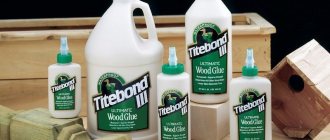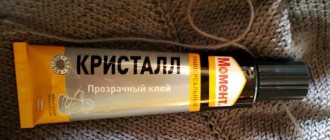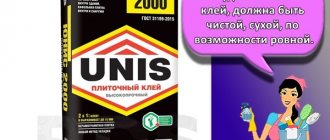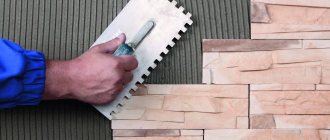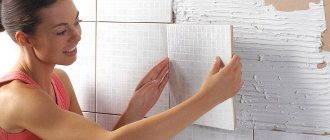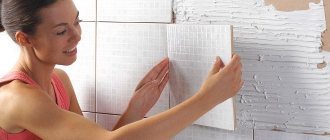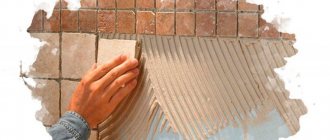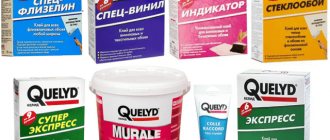EK 3000 glue is a powder mixture that must be mixed with a certain amount of water to prepare an adhesive solution. Products of this type can be used in professional construction work and in ordinary home repairs.
Composition of glue "EK":
- Sand of fine fractions.
- Modifiers, plasticizers, fillers.
- High quality cement.
Important! It is not recommended to use EK glue if installation of porcelain stoneware, large-format tiles, or heavy tile cladding is required. In this case, epoxy-based solutions should be used.
Advantages and disadvantages
It is convenient to work with EC 3000 glue:
- 1 square meter requires 2.5-3 kilograms of glue. The thickness of the layer when applied is 5 millimeters. For dense walls this is a low consumption. But for porous surfaces it needs to be increased. On average, 25 kilograms of powder require 6 liters of water, and the mixture is enough for 6 square meters of surface.
- The mixture is suitable for use for a long time. In 4 hours you can have time to decorate a bathroom or a kitchen backsplash.
- Within 15 minutes, the master can correct the position of the tile after fixing it, which also makes the work easier.
- Plastic glue is easy to apply, does not crumble, does not break.
Disadvantages include packaging and technical features of work:
A large volume of glue is packed in paper bags of 25 kilograms
During transportation, the packaging may tear, so the bags should be handled carefully. In damaged packaging, the glue loses its adhesive properties and absorbs moisture. Powder spilled on the floor must be cleaned up immediately
Particles eat into the surface and are not cleaned. Glue consumption increases when laying heated floors. If electric mats are placed in the glue layer, its thickness increases to 10 millimeters versus the standard 5-6. EC 3000 glue holds façade cladding well. Stone slabs do not lag behind the vertical base in frost -25 It is important to thoroughly clean the surface of dust before work, otherwise the strength of the adhesive will be significantly reduced.
Craftsmen appreciate EC 3000 cement adhesive for its ease of preparation, ease of use, durable coating and savings on minor repairs. The result is a high-quality cladding that will withstand frost and moisture inside or outside the room.
Share link:
Warranties and storage
If the package of EK glue is not damaged, it can be stored at home in a dark and dry place for 6-9 months. The room should not be damp. Also, do not allow moisture to get on the packaging, otherwise the dry mixture will no longer be suitable for use in the future.
Transportation of this adhesive composition must also be carried out in such a way that the packaging is not exposed to high humidity, temperature changes, or direct contact with liquids.
Characteristics of the product
EK 3000 glue compares favorably with analogues in its properties. It has a high level of adhesion to the surface, due to which the tiles will not fall down when sticking to vertical bases. Using this material, you can glue slabs using the top-down technique; there will be no problems with the quality of the work.
Main technical characteristics of the material:
- glue shade - gray;
- grain size in the powder fraction is less than 1.25 mm;
- solution readiness - 4 hours;
- open time - 15 minutes;
- the ability to correct defects after applying the product - 20 minutes;
- consumption per 1 m2 - 2.8 kg/sq. m provided that a 6*6 mm spatula is used with an angle of 60 degrees;
- glue layer thickness - 3–6 mm;
- adhesion - 1.0 MPa;
- temperature during operation +5…+30 degrees;
- drying period - 24 hours.
How to work with glue?
Application of the prepared EK 3000 adhesive should be carried out using a traditional notched trowel. You should not immediately treat the entire wall with the adhesive solution - you need to apply the solution only to the area of the surface that is supposed to be tiled within 10-15 minutes. The tile itself does not need to be wetted or treated in any way before use.
It is recommended to work with “EK” glue in the following sequence:
- First, apply EK 3000 glue to a section of the wall using a notched trowel.
2. Then you need to attach the tile to the treated surface, pressing it slightly with your hands.
3. You can adjust the position of the tiles immediately or 10-15 minutes after gluing (20 minutes after gluing, it will no longer be possible to change the position of the tiles - if it turns out uneven, the tile must be dismantled, the base must be cleaned of the laid mortar and everything must be done again).
4. After gluing adjacent tiles, the seam between them must be cleaned. It is necessary to fill the tile joints with grout only after the adhesive composition has completely dried (after 1-2 days).
Important! If “EK” adhesive is used to lay tiles on the floor, then it can be subjected to loads only 24-36 hours after completion of the work (in other words, you cannot walk on the floor until the adhesive solution has completely hardened).
Precautionary measures
The dry mixture of “EK” glue contains special cement and various additives, so during the preparation of the solution, the mass will be very alkaline. Therefore, the prepared mixture should not be allowed to come into contact with the skin.
If the finished composition gets on the skin, the area should be immediately washed with warm running water. It is recommended to carry out installation work using rubber gloves, safety glasses, and a respirator.
Application of EK 3000 glue
Tile adhesive EK 3000 Universal looks like a dry powder for preparing a working solution. This construction product contains fractionated sand and specially prepared cement. Modifiers and special fillers are also added to the EK 3000 mixture.
Using this product you can glue medium and small sized ceramic tiles. The material is best suited for stone slabs with water absorption up to 1%. Also in the description of this universal adhesive it is indicated that it is suitable for gluing tiles to the following substrates:
- plastered surfaces;
- concrete;
- brick coverings;
- aerated concrete;
- other minerals.
In addition to ceramics, the product is used for working with artificial stone; it is used to install heated floors in rooms. The glue helps to level out small unevenness in walls and floors, but not more than 15 millimeters. A special feature of operation is the need to use a starting profile if the tiles are applied to walls and other vertical bases.
Types and technical characteristics of EK tile adhesives
The EK line includes several adhesives, each of which differs in composition. Thanks to this variety, consumers can choose the material for a specific type of tile. EK 3000 belongs to the group of universal adhesives, the rest are highly specialized.
Regardless of the type of product chosen, it is not recommended to use this brand of dissolved powder on large-format tiles, heavy tiles and porcelain tiles.
The difference between the given adhesive compositions is insignificant. These products can be used for cladding concrete, foam concrete, plastered walls, brick, and stone.
3000
Universal adhesive EK 3000 has the following characteristics:
- recommended operating temperature - 10-25 degrees;
- adhesion force of the material to the surface - 1 megapascal;
- the time required to prepare the adhesive composition is 4 hours;
- average material consumption - 2.5-3 kilograms per square meter;
- Drying speed: 20 minutes.
Other types of EK glue have similar characteristics.
2000
EK 2000 glue is characterized by the following features:
- suitable for fixing tiles on external and internal walls;
- sticks to mineral materials, plastered walls, concrete and brick;
- used for restoration of minor defects;
- used for gluing medium and small tiles;
- the adhesion index is 0.7 megapascal;
- Hardening time after application is 10 minutes.
See also
Purpose and technical characteristics of Macroflex adhesive foam, rules of application
EK 2000 is characterized by increased frost resistance and plasticity. The finished glue must be used within three hours.
4000
The product is used for gluing heavy slabs and porcelain stoneware. EK 4000, due to increased adhesion reaching 1.2 megapascals, fixes the material well on horizontal and vertical surfaces. This product can be used to fill voids and glue mineral wool with polystyrene foam.
1000
The product is used for fixing porous materials: aerated concrete, foam concrete and others. EK 1000 adheres tiles well to vertical and horizontal surfaces of various types.
6000
This type of glue is used when finishing surfaces with mosaics. Material used for finishing:
- swimming pools;
- bath;
- heated floors;
- joints and other surfaces.
EK 6000 adhesive is not demanding on the level of water absorption of the tiles.
5000
This type of adhesive composition is created for tiling pools, fountains and other water reservoirs. The material is suitable for processing external walls.
EK 5000, in comparison with other adhesive compositions, is characterized by increased moisture resistance.
Specifications
EC 3000 glue is sold in cans and bags of 5 or 25 kilograms and is good for six months from the date of issue.
Viability of solution
The mixture remains plastic and soft for 4 hours. Then the mass hardens, it is difficult to scoop it out with a spatula and spread it.
Working time with tiles
The position of the slab can be corrected within 15 minutes after installation
Extra time is important when working with uneven surfaces and tiles with complex patterns
Adhesion degree
The glue has high adhesiveness - 1 MPa. It is used for laying heavy tiles using top-down technology. Good adhesion between the wall, glue and cladding prevents the coating from sliding under its own weight.
Compressive strength
An indicator of 15 MPa determines the high strength of the coating. The cladding will not fall off from strong impact or pressure, constant load from furniture, loads or steps.
Frost-resistant glue withstands 35 cycles of thawing and freezing.
Ambient temperature
You can work with glue in moderate heat. The temperature range in which the properties of the mixture are preserved is from +5 to +30 degrees. At sub-zero temperatures, the water in the mixture will freeze. High temperature damages adhesive properties.
Consumption by brand
| Name | How much tile adhesive is needed per 1m2 (comb size 6*6 mm) | Recommended layer thickness, mm |
| Eunice Plus | 3,5 | 3-15 |
| Unis 2000 | ||
| UNIS XXI | ||
| Unis HiTech | ||
| Eunice Granite | 3-10 | |
| Eunice Belfix | ||
| Unis Fix | 3,5-5 | 3-15 |
| Eunice Pool | 3,1 | 3-6 |
Ceresit
| Name | Max. tile side length, cm | Comb teeth size, mm | Consumption, kg per sq. m |
| Ceresit CM 9 (for ceramic tiles) | 10 | 4 | 2 |
| 15 | 6 | 2,7 | |
| 20 | 8 | 3,2 | |
| 30 | 10 | 4,2 | |
| Ceresit CM 11 Plus (for tiles and porcelain stoneware) | 5 | 3 | 1,7 |
| 10 | 4 | 2 | |
| 15 | 6 | 2,7 | |
| 25 | 8 | 3,6 | |
| 30 | 10 | 4,2 | |
| Ceresit CM 12 (for porcelain stoneware and large tiles) | 30 | 10 | 4,2 |
| 60 | 12 | 6 | |
| Ceresit CM 14 Extra | 15 | 6 | 2,7 |
| 25 | 8 | 3,6 | |
| 30 | 10 | 4,2 | |
| 45 | 12 | 6 | |
| Ceresit CM 16 (elastic) | 10 | 4 | 2 |
| 15 | 6 | 2,7 | |
| 25 | 8 | 3,6 | |
| 30 | 10 | 4,2 | |
| Ceresit CM 17 (super elastic) | 10 | 4 | 1,5 |
| 15 | 6 | 2,1 | |
| 25 | 8 | 2,7 | |
| 30 | 10 | 3,2 | |
| 40 | 12 | 4,1 | |
| Ceresit CM 115 (marble and mosaic) | 10 | 4 | 2,5 |
| 15 | 6 | 3,4 | |
| 25 | 8 | 3,9 | |
| 30 | 10 | 4,4 | |
| Ceresit CM 117 (elastic adhesive for facade tiles, stone and porcelain tiles) | 10 | 4 | 1,8 |
| 15 | 6 | 2,5 | |
| 25 | 8 | 3,2 | |
| 30 | 10 | 3,6 | |
| 40 | 12 | 4,7 |
Kreps
| Name | Consumption, kg/m2 | How long will a 25 kg package last, m2 |
| Plus | 2-4 | 8 |
| Aqua | ||
| Base | ||
| Standard | ||
| Super | ||
| Kreps Prostokley | ||
| Reinforced | 2-3 | |
| Express | ||
| White Reinforced |
Bolars
| Name | Average consumption (comb size 6 mm), kg/m2 | Max. layer thickness, mm | One 25 kg bag is enough for, m2 |
| Base | 3-3,5 | 10 | 8 |
| Standard | 3-3,5 | 10 | 8 |
| Elastite | 3-3,5 | 6 | 8 |
| Plus | 2,7-3,2 | 6 | 8 |
| Granite | 2,7-3,2 | 6 | 8 |
| Aqua plus, for swimming pools | 2,5-3 | 6 | 9 |
| Elite | 2,5-2,8 | 6 | 10 |
| Express | 3 | 6 | 8 |
Hercules
| Name | With a word of 1 mm consumed, kg / sq. m | Maximum layer thickness, mm |
| Universal GM-35 | 1,53 | 20 |
| Superpolymer GM-45 | 1,53 | |
| For porcelain tiles GM-55 | 1,53 | 20 |
| Elastic GM-195 | 1,43 | |
| For heated floors GM-125 | 1,49 | |
| Heat resistant GM-215 | 1,81 | 20 |
| Strong GM-115 | 1,53 | 20 |
| For mosaic GM-165 | 1,33 | |
| Aqua-stop GM-145 | 1,49 | |
| Basic GM-25 | 1,53 | 10 |
Vetonit
| Name | With a layer of 1 mm consumption, kg / sq. m | Maximum layer, mm |
| Optima | 1,29 | 10 |
| Easy fix | 1,29 | 15 |
| Granite fix | 1,29 | 15 |
| Profi plus | 1,35 | 15 |
| Ultra fix | 1,29 | 15 |
| Ultra fix winter | *3-3,5 | 15 |
| Marble | 1,29 | 15 |
| Absolute | *3-3,5 | 30 |
| weber.vetonit RF | *3-3,5 | 15 |
| weber.vetonit RFF | *3-3,5 | 15 |
| Name | Dry mixture consumption (teeth size 6*6 mm), kg/m2 |
| EK 1000 WIDE | 3,4 |
| EK 2000 KERAMIK | 3,3 |
| EK 2000 KERAMIK ECO | 3,3 |
| EK 3000 UNIVERSAL | 2,8 |
| EK 3000 UNIVERSAL ECO | 2,8 |
| EK 4000 TITAN | 2,7 |
| EK FAST FIX | 2,7 |
| EK 5000 AQUA | 2,7 |
| EK 6000 MOZAIK | 2,8 |
| EK 8000 KAMIN | 2,7-2,8 |
Plitonite
| Name | Maximum tile side length, mm | Height of teeth, mm | Dry glue consumption, kg/m2 | How much is 15 kg, m2? |
| Plitonite A | 301 | 12 | 5,1 | 5 |
| Plitonite B profi | 301 | 12 | 5,1 | 5 |
| Plitonite C light | 51-108 | 4 | 1 | 15 |
| 109-200 | 6 | 1,5 | 10 | |
| 201-250 | 8 | 2,1 | 7,1 | |
| 251-300 | 10 | 2,6 | 5,8 | |
| > 301 | 12 | 3,1 | 4,8 | |
| Plitonite Bb | 51-108 | 4 | 1,8 | 14 |
| 109-200 | 6 | 2,6 | 9 | |
| 201-250 | 8 | 3,5 | 7 | |
| 251-300 | 10 | 4,4 | 6 | |
| > 301 | 12 | 5,3 | 5 | |
| Plitonite V superfloor | 109-200 | 6 | 2,9 | 9 |
| 201-250 | 8 | 3,9 | 6 | |
| 251-300 | 10 | 4,9 | 5 | |
| > 301 | 12 | 5,9 | 4 | |
| >401 | 15 | 7,3 | 3 | |
| Plitonit SuperFire ThermoGlue (W) | — | — | 1,4-4,5 | 25 kg per 9 m2 with 6 mm teeth |
| Plitonit -AquaBarrier HydroGlue | Prospectors |
| Name | Approximate consumption, kg/m2 |
| Standard | 3-5 |
| Plus | |
| Lux | |
| Premium | |
| Fast |
About the manufacturer
The Prospector company appeared on the Russian market in 1992. Initially, the company specialized in the production of putty. Over time, it was decided that it was necessary to expand the range of products through the production of ready-made building mixtures.
Having adopted relevant European experience, the organization’s specialists quickly managed to establish a full-fledged production cycle for products that are very popular among builders.
The main advantages of the company Prospectors are as follows:
- production of more than 80 types of products to perform various construction tasks;
- fully automated production;
- significant development dynamics, which made it possible to make the brand a market leader;
- introduction of modern technologies into the process of manufacturing goods;
- presence of 15 high-tech production lines;
- Constant checks of product quality at various stages of its production.
The Prospector company has established a process for certifying its own products in the GOST system. Additionally, all types of products constantly undergo appropriate sanitary and epidemiological examination, confirming their full compliance with the requirements of Rospotrebnadzor.
Ceresit CM 17
The main feature of Ceresit CM17 is high elasticity and good adhesion. Due to this, it can be used for laying deformable bases: warm floors, plasterboard, chipboard. It is not afraid of moisture or frost, and can be used for lining swimming pools, for interior and exterior work, tiles and large-format porcelain tiles (with the exception of marble).
Ceresit 17 is available in two versions: regular and low-dust (marked “Stop Dust”).
Specifications
| Mixing proportions | When laying on walls: 8.5-9 liters of water per 25 kg of dry mixture. When laying on the floor: 9-9.5 liters of water per 25 kg. |
| Time to use the mixture after mixing | Minimum 2 hours |
| Conditions of use | Base and air temperature from +5 to +30, air humidity less than 80% |
| Opening hours | From 30 minutes |
| Tile adjustment time | From 30 minutes |
| Sliding tiles | No more than 0.5 mm |
| Grouting joints | In 24 hours |
| Adhesion to concrete after 28 days | More than 1.3 MPa |
| Frost resistance | At least 100 cycles |
| Operating temperature | From −50 to +70 |
| Package | Bags 5 and 25 kg |
Facing adhesive
Ceresit cm17
Ceresit CM17 is a tile adhesive whose main advantage is elasticity and adhesion. Thanks to these qualities, this composition can be used not only when installing tiles, but also when laying deformable bases. This product is not afraid of moisture and frost; it can be used for laying tiles in the pool, bathroom and kitchen. In addition to ceramic tiles, high adhesion to large-sized porcelain stoneware is achieved. Ceresit 17 is produced in two forms: regular and low-dust. Price - 560 rubles. Also, Ceresit tile grout is of excellent quality and affordable price.
You can find out which tile adhesive is best for the bathroom in this article.
Ceresit SM 11
When choosing glue from the manufacturer Ceresit, people most often pay attention to Ceresit SM 11. The reason for this popularity is explained by the versatility of the glue. It can be used for cladding both inside and outside the house. It adheres perfectly to ceramic tiles and porcelain tiles. Resistant to frost and moisture. To obtain maximum adhesion, you need to use ceramic tiles with a water absorption of more than 3%, and their size is up to 40x40 cm. And also treat the surface with Ceresit CT 17 primer. If you are installing porcelain tiles, then this adhesive can only be used for cladding rooms with low loads .
Yunis tile adhesive technical characteristics and other data on the building material can be read in this article.
Often, the plasticizer CC 83 is added to the composition of Ceresit SM 11, thanks to which this adhesive can be used for laying tiles and bathroom baseboards with different water absorption, as well as for laying on heated floors. Cost: 685 rubles. For convenience, the manufacturer immediately suggests using Ceresit CE 40 grout.
What technical characteristics of ceresit cm17 tile adhesive can be found out by reading this article.
Properties
The popularity of Prospector tile adhesives is due to their respective performance properties, such as:
Versatility
The company's dry mixes can be used with almost all types of tiles, both for walls and floors.
They can be used indoors and outdoors - both in normal and high humidity conditions.
Plastic
When properly prepared, Starateli glue is easily applied to any substrate. Working with it does not require significant labor costs, so it can be carried out not only by professionals, but also by inexperienced workers.
Water resistance
Almost all dry mixtures can be used in rooms with high humidity levels. These include, among other things, the bathroom and toilet.
Good adhesion
It is allowed to apply glue to almost any surface, regardless of the material, be it brick or concrete base.
Standard curing temperature and humidity
Thus, tile adhesives from the company Starateli are currently in great demand among professional builders.
Varieties
EK adhesive compositions are produced in various modifications. Glue under the “3000” brand is universal in use, therefore, if necessary, it can be replaced with other, more specialized mixtures:
- Keramik. Another universal adhesive used for gluing small tile materials to different types of subfloors: concrete, brick, mineral, block, aerated concrete, etc. The adhesive composition is used for external and internal cladding work; it has a high level of frost resistance and plasticity.
- Titan. Adhesive composition for gluing large tile materials and porcelain stoneware slabs, large-sized artificial and natural stone, slab materials with varying degrees of moisture absorption. The adhesive can be used for finishing horizontal and vertical bases.
- 1000 WIDE. This type of adhesive mixture is used for the installation of block and slab materials, which must be laid on a thick layer of mortar: cement blocks, concrete slabs, foam concrete, aerated concrete blocks, various porous materials.
- 6000 Mozaik. A specialized adhesive composition for laying marble, mosaic, porcelain stoneware decorative finishing materials, including transparent ones (regardless of the degree of moisture absorption). This type of mortar is also used for sealing joints and seams.
- 5000 Aqua. This adhesive mixture is also specialized. The manufacturer recommends using it when installing tile and porcelain stoneware finishing materials in any premises where the cladding will be constantly in contact with water (showers, bathrooms, swimming pools). EK 5000 Aqua adhesive is used for laying tile materials in outdoor conditions: balconies, loggias, attics, terraces, as well as to improve the landscape design of a plot of land.
EK 3000 adhesive is recommended to be used for laying small tiles at home. If you intend to install heavier or large-format tile materials, then you should use specialized compounds, which are presented in variety in the catalog of the same manufacturer.
Review and preparation of EK glue (2 videos)
Types and use of tile adhesive EK 3000 (20 photos)
Preparing the base
The temperature regime should not go beyond the range indicated above, this applies to the base on which the glue is applied and the material itself. Before starting work, you should thoroughly clean the base from dirt, dust, grease, enamel residues and other substances that may negatively affect the adhesion rate.
If there are craters or holes deeper than 5 mm on the base, they must be filled by plastering with a suitable product. If the base is made of a porous material that absorbs a lot of moisture, it is pre-primed. It is recommended to use primers with deep penetration such as EK GS300 Deep.
EK 3000: features of preparatory work before use
Tile adhesive EK 3000 is used for construction work outside and inside. This solution has a wide range of applications. It perfectly fills tile joints and levels the surface. If you follow the instructions, you can get a high-quality result.
Laying tiles with glue
To calculate the correct amount of EK 3000 that will be needed for construction or repair work, you need to measure the cubic capacity of the surface area where you plan to lay the tiles.
- Using this adhesive, you can lay the tiles starting from the top. Tile adhesive EK 3000 is characterized by high adhesion up to 1 MPa. By choosing it, you can forget about such a common problem as tiles sliding. To take advantage of all the positive characteristics of the glue, you must strictly follow the instructions.
- Tile Adhesive 3000 must be used under certain conditions. The temperature of the environment and the base can vary between +5...+30 degrees.
- The surface that is being prepared for cladding must be durable. It should be thoroughly cleaned of all contaminants, as they will weaken the adhesion of the glue to the base. Unevenness deeper than 5 mm is pre-leveled using plaster mixtures. If the substrates strongly absorb moisture, it is recommended to treat them before starting work with EK 3000. For this, the primer EKANTISEPTIC/EKG300DEEP is used.
Safety rules for working with EK 3000
The composition contains cement. When the mixture is added to water, an alkaline reaction occurs. To prevent the prepared adhesive solution from getting on the skin of your hands, wear gloves. If it gets into your eyes, they should be rinsed immediately with water. In case of emergency, you should go to the hospital.
Customer Reviews
Consumers who have already used tile adhesive appreciated the product and left positive reviews about its quality. Its consumption is considered optimal. If you take a 6x6 mm spatula for work, then no more than 2.8 kg of adhesive will be consumed per 1 sq.m. EK 3000 glue is an excellent choice that will not disappoint customers.
If you need to cladding the plinths of buildings or areas with high levels of humidity, then consider choosing EC 3000 adhesive. It is also excellent for underfloor heating or for swimming pools. Consumption per 1 sq.m is from 2.5 to 3.0 kg, provided that the layer thickness does not exceed 5 mm. EC 3000 tile adhesive retains its adhesive properties for only 10 minutes. Therefore, you should not spread a large surface area at once. These two options can be safely purchased if you follow the reviews.
In the photo you can see what EK 3000 tile adhesive looks like, which is considered a universal adhesive for tiles and porcelain stoneware. It will help create a durable cladding coating that can delight its owners for many years.
How to prepare the solution
The glue is mixed in water. On average, 250 milliliters of liquid are required per kilogram of dry powder. When stirring, you can add water, but the finished mixture should not be liquid. Normal consistency is similar in thickness to rich sour cream.
Instructions for preparing the mixture:
- measure the minimum volume of water;
- pour the liquid into a plastic container;
- pour powder;
- stir with a construction mixer until the mass thickens;
- let it stand for 5-10 minutes;
- Stir again; if the mass is too thick, add water;
- the mixture is ready.
It is better to stir the powder with a special tool, since it is difficult to obtain a uniform consistency by hand. To get a finished mixture without lumps, you can stir it with a drill using a special attachment.
Preparation of the solution
To properly prepare the adhesive composition, you must accurately measure the amount of water. For 25 kg of glue powder you will need from 5.75 to 6.75 liters of water, depending on the desired thickness. The product is poured into water, which is poured into a large container, and mixed using a drill with an attachment or a construction mixer. The glue is ready as soon as the mass becomes homogeneous and does not contain lumps. Once ready, it takes another 10 minutes for the product to infuse and the particles to swell. The mixture must be used within 4 hours.
Working with glue
Apply the product with a special notched spatula. You should not immediately apply glue to large areas of walls or floors - you need to glue the tiles in 15 minutes, so you should measure your capabilities. Before gluing, the boards must be dry and not wetted. The procedure is as follows:
- attach the tile to the base;
- press it well with your hands;
- You can change the position within 20 minutes;
- Immediately after joining adjacent tiles, the joint between the tiles should be cleaned
- the final filling of the joints is done after completing work with the tiles, and you need to wait for complete drying (16–24 hours);
- If the floor is covered with material, it can be put into operation only after 24 hours, but gentle loads must be observed for another 3 days.
Safety precautions
The powder contains cement, so when mixed with water, the reaction of the mass will be alkaline. If it comes into contact with exposed skin, irritation occurs; this should not be allowed to happen. If the solution splashes into your eyes, wash them immediately, then consult a doctor.
Certificates
Create innovative solutions in the field of finishing materials to provide consumers with products that anticipate their needs in the areas of functionality and quality, making their work simple and effective.
EC Chemical 2008—2019. All rights reserved.
607630, Nizhny Novgorod region, Bogorodsky district, Kudma village, Kudminskaya industrial zone street No. 1, building 4, room 1
Adhesive 3000 is available on the market in the form of a powder mixture. It consists of a cement binder, fractionated sand, special fillers, and modifying additives. This composition has good performance characteristics.
Tile adhesive Kreps
When deciding which glue to use to strengthen porcelain tiles, you can choose Kreps glue, the cost of which is 280 rubles. Creps is a bathroom tile adhesive designed for exterior or interior use. It has excellent adhesion to concrete, cement, plasterboard and plaster surfaces. The composition containing a hardening accelerator significantly reduces the time required for commissioning construction projects.
The main advantages of the adhesive composition include:
- plastic;
- water resistance;
- frost resistance;
- high tenacity (0.7 MPa);
- Possibility of use when installing a “warm floor” system.
After diluting the mixture with water, an elastic mass is formed that is able to maintain its qualities even in severe frost conditions. The product contains fractionated sand and cement.
Tile adhesive is a good adhesive material that can be used when laying tiles with an area of 400x400 mm. The thickness of the tile can be 8 mm and the height is 1 m.
The use of this composition is permitted for laying tiles on surfaces with a high level of heat transfer, for example, fireplace trim. If you choose Kreps, which contains antifreeze, you can lay the tiles at temperatures down to -10 °.
General requirements for tile adhesive
All types of adhesive mixtures for laying tiles must have a certain set of necessary technical characteristics, which, depending on the type of adhesive, may differ in value. Let us list these properties.
During operation (before the solution hardens):
- ease of preparation;
- elasticity (should fit well on the surfaces to be glued);
- sufficient lifespan (the ability to work out the prepared amount of mixture, correct displaced tiles before the glue hardens);
- high adhesion (adhesion of the solution to the surfaces of the material and base);
- low fluidity and resistance to slipping (holding the tiles in place on a vertical surface).
First of all, the glue must have increased water and frost resistance.
After the tile adhesive has cured:
- compressive and shear strength;
- water resistance;
- heat resistance;
- frost resistance;
- resistance to chemical agents;
- elasticity (the ability to absorb the stresses of the cladding material that arise when temperatures change).
Sequence of work using glue
The adhesive solution should be applied to the base prepared in advance with a notched trowel. In this case, the surface area coated with glue must be covered with ceramics within 15 minutes. When laying, the tiles are pressed against the base. After this, the position of the ceramic products can be adjusted within 20 minutes.
Upon completion of installation, you should clean the seams between the tiles, filling which is recommended to be done after the adhesive has dried. This time varies from 16 hours to 24 hours. Full operational load is possible only after 3 days. After use, the instrument is cleaned with water.
Important! The tiles must not be wetted with water before gluing!
Instructions
Preparing the base
The temperature of the base and the environment must be in the range from +5 °C to +30 °C. The base must be strong, thoroughly cleaned of dust, dirt, oils, fats, loose paint residues and other substances that can weaken the adhesion of the putty layer to the base. Irregularities with a depth of more than 4 mm must first be leveled with plaster mixtures EK TG20, EK TG40 or EK TG40 WHITE. It is recommended to pre-treat uneven or highly absorbent substrates with deep penetration primer EK GS300 DEEP, EK GS300 TIEFENGRUND or EK GS400 ANTISEPTIC.
Preparation of the solution
To prepare the EK K300 solution you need:
- Take a precisely measured amount of water (1.32-1.74 l per 3 kg bag, 8.8-11.6 l per 20 kg bag)
- Pour the mixture into water
- Mix using a construction mixer or a drill with a special attachment until a homogeneous mass is obtained.
- Maintain a technological pause of 5-10 minutes for the solution to mature
- Stir again
After this, the putty is ready for use within 60 minutes with occasional stirring
Work order
The putty is applied to the base with a smooth steel spatula. To level small areas, a 30 cm wide spatula is used. The permissible thickness of one layer for continuous filling is no more than 3 mm, for partial leveling and filling of unevenness is no more than 15 mm. If it is necessary to apply a thicker layer, the solution is applied in several passes at the time intervals necessary for the previous layer to harden. Drying time for one layer is from 5 to 9 hours (depending on the thickness of the application layer, temperature and humidity of the environment). After drying, the surface is sanded using fine sandpaper or sanding mesh.
Sealing joints of plasterboard sheets. The first main layer of putty is applied to the joint, into which the reinforcing tape (serpyanka) is pressed. Apply a covering layer of putty with a wide spatula. After drying, the surface is sanded using fine sandpaper. Uncured material is washed off the tools with water. The hardened material is removed mechanically.
How to use it correctly
The principle of working with EK 3000 is described in the instructions on the packaging. The preparation of the base on which the tiles will be laid is always carried out according to the same scheme.
Preparing the base
All working operations with the adhesive mixture are recommended to be carried out at t=+10…+25 °C. All vertical or horizontal bases are thoroughly cleaned of dirt, dust, greasy marks, and remnants of old cladding, which can impair the adhesion of the tiles to the wall or floor. All surface defects whose depth exceeds 5 mm must be repaired with plaster.
If the tiles are laid on a porous base that absorbs water well, it must be pre-treated with a primer with antiseptic additives.
Some experts recommend priming any substrate to prevent mold. The recommended compositions are EK GS300 Deep, EK GS3000 TIEENGRUND, EK GS400 ANTISEPTIC.
How to prepare the solution
The proportions and sequence of steps for preparing the mixture are described on the packaging. For 25 kg of dry composition, add 5.75-6.75 liters of water. A bag weighing 5 kg requires 0.8-1.15 liters of water. The volume of liquid depends on the required thickness of the solution. The powder is poured into water in a separate clean container, the mass is mixed until smooth without lumps with a drill or a construction mixer. After mixing, the mixture stands for 10-20 minutes, after which you can begin finishing. The prepared batch must be used within 4 hours.
Application of adhesive composition
- Each tile is thoroughly dried.
- A sufficient amount of mortar is applied to the base using a notched trowel. It is important not to apply the adhesive to a large area at once, as there may not be enough time to level the position of the tiles. The layer thickness should be 1-4 mm, the exact value is indicated on the glue packaging.
- The cladding is pressed tightly to the base.
- Excess solution is immediately removed with a rag. If necessary, the position of the tile is corrected (possibly within 10 minutes).
- After installation, the seams are cleaned.
- Grouting of joints is carried out 16-24 hours after installation. The waiting time depends on the type of mixture.
- When gluing the floor, you can start using the coating within a day, but for another three days you need to ensure gentle loading.
How to calculate consumption
The average consumption per 1 m2 is 2.5-3 kg. The indicator depends on the brand of glue, the consistency of the solution and the thickness of the applied layer.
Precautionary measures
One of the components of EK 3000 is cement. When in contact with water, cement gives an alkaline reaction.
If such a solution gets on the skin, it can cause redness, irritation and other unpleasant reactions. It is recommended to carry out all work with glue wearing gloves and safety glasses. If the solution gets on the skin or mucous membranes, they should be washed with a large stream of water.
Common Mistakes
- Insufficient or incorrect preparation of the base.
- Failure to follow the rules for preparing the adhesive solution.
- Applying too much or too thin a layer of mortar.
- Laying not level, without marking.
- Premature grouting of joints.
Making any of the mistakes leads to a decrease in the service life of the cladding.
Calculation example
It is easiest to calculate the mixture consumption when the required brand of composition is known exactly.
If the brand of the mixture has not yet been chosen, but you need to estimate the costs of purchasing it, you can use the average value.
As an example, we can take the most common cement-based composition, the consumption of which per 1 mm of layer is 1300 g. This amount is multiplied by the thickness of the layer.
- If a tile measuring 20x30 cm is glued, then the solution is applied in a layer of 3 mm, which means that 3.9 kg of glue will be used per 1 m2 (1.3 kg * per 3 mm).
- A base of 30 m2 will require 30 x 3.9 = 117 kg of tile adhesive.
- When small tiles are laid on the same area, the adhesive seam will be thinner, which means less consumption: for a size of 10x10 cm it will take 1.3x2x30 = 78 kg.
- With larger slab sizes, the volume of the solution increases: for a size of 60x60 cm you need 1.3x6x30 = 234 kg.
Calculation by any method will be approximate. In practice, the required amount of glue depends not only on the brand of glue, but also on the other factors listed above.
Common Mistakes
When finishing walls, installers usually make the following mistakes:
- they do not prepare the base or do it incorrectly (do not prime, do not remove grease, and so on);
- do not follow the rules for preparing the adhesive composition;
- apply glue in excessive or insufficient quantities;
- glue the tiles not according to the level and pre-applied grid (drawing);
- seams are worn out prematurely.
Due to each of the above errors, the service life of the tile is significantly reduced.
Tile adhesive EK 2000 and 3000
When thinking about which tile adhesive is best to use in the bathroom, you can choose the EK 3000 or EK 2000 product. After complete drying, this adhesive becomes strong and can no longer shrink. Dry mix EK 3000 is produced containing cement, fractionated sand, modifying additives and special fillers. This set of basic components in the adhesive composition provides excellent performance characteristics.
According to the instructions for use of tile adhesive EK 3000, ceramic tiles should be medium or small in size. The composition has a water absorption level of no more than 1%. It can be applied to concrete, brick, aerated concrete or plaster. Its price is 230 rubles.
EK 2000 adhesive is often used to create porcelain stoneware floor coverings. Using this product you can finish heated floors and wall cladding inside and outside the house. The material is a composition of wide application; it can be used to level surfaces. The applied layer must have a thickness not exceeding 5 mm. The cost of the product is 205 rubles. per package.
Scope of use
The use of tile adhesive “EK 3000” is relevant in situations where it is necessary to lay tiles that are small in weight and dimensional characteristics. The manufacturer recommends using this adhesive composition for gluing any stone products with a moisture absorption level of no more than 1%.
Using this composition, you can stick tiles on the following types of surfaces:
- Concrete.
- Foam concrete.
- Plastered.
- Made of brick, natural or artificial stone.
- Other types of surfaces that can support the weight of the tiles being laid.
Important! It is allowed to use EK 3000 glue when installing stone facing materials on the floor in rooms with floor heating systems.
